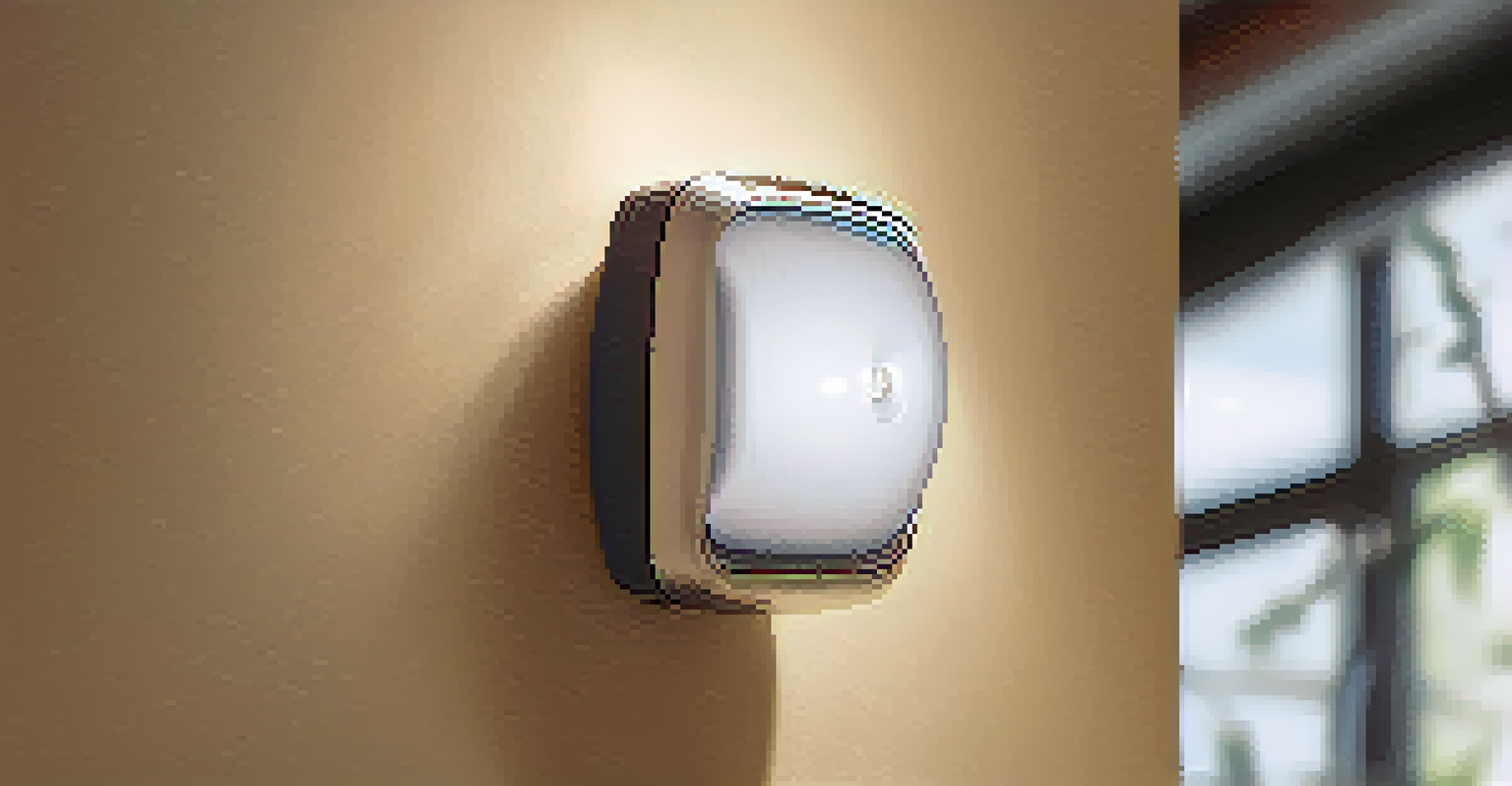How to Install Motion-Sensor Lights for Safety

Understanding the Benefits of Motion-Sensor Lights
Motion-sensor lights are a fantastic addition to any home, offering enhanced safety and security. They automatically turn on when they detect movement, providing light when you need it most. This not only deters potential intruders but also makes navigating your property safer at night.
Safety doesn't happen by accident.
Imagine walking up to your home on a dark evening and suddenly being greeted by a flood of light as you approach. It's a comforting feeling that increases your awareness of your surroundings and helps prevent accidents. Plus, these lights can help you save on energy costs since they only operate when needed.
Moreover, motion-sensor lights can be strategically placed to illuminate pathways, driveways, or backyards, acting as a safety net for your family and guests. Their ability to enhance visibility can prevent falls and injuries, making them a wise investment for any homeowner.
Choosing the Right Type of Motion-Sensor Light
Before installing motion-sensor lights, you'll want to choose the right type for your needs. There are various options available, including floodlights, wall-mounted lights, and even solar-powered models. Each type offers different benefits, so it's essential to consider where you'll be placing them and how much light you need.

For example, floodlights are great for larger areas like driveways or backyards, while smaller wall-mounted lights can suit entryways or porches. Additionally, solar-powered lights can be a fantastic eco-friendly option, especially if you want to save on electricity bills. Just ensure they receive adequate sunlight during the day for optimal performance.
Enhance Safety with Motion-Sensors
Motion-sensor lights automatically illuminate areas when they detect movement, enhancing safety and security for your home.
Take your time to assess the areas you want to illuminate and determine which type of motion-sensor light will work best. This upfront consideration will ensure you make a choice that meets your safety needs effectively.
Gathering Your Tools and Materials for Installation
Installing motion-sensor lights can be a straightforward process if you have the right tools and materials on hand. Typically, you'll need a screwdriver, wire strippers, a drill, and possibly a ladder, depending on where you're installing the lights. Make sure you also have your motion-sensor lights and any additional mounting hardware.
The best way to predict the future is to create it.
Before you begin, it's a good idea to read the manufacturer's instructions. These will guide you on any specific tools or installation steps required for your particular model. Having everything prepared will streamline the installation and reduce surprises along the way.
Lastly, don’t forget to prioritize safety. If you’re working with electrical wiring, ensure the power is turned off at the circuit breaker to prevent any accidents. Taking these precautions will help you feel more confident as you tackle the installation process.
Selecting the Ideal Location for Your Lights
Choosing the right location for your motion-sensor lights is crucial for maximizing their effectiveness. Ideally, you'll want to place them where they can detect movement in high-traffic areas, such as entryways, garages, and pathways. This ensures that the lights activate when needed, providing safety for you and your guests.
Consider the range of the sensor, as most models have a detection radius of 20 to 30 feet. Placing lights too high or too far from the area you want to monitor may limit their effectiveness. Aim for a height where the sensor can easily detect movement without being obstructed by walls or trees.
Choose the Right Light Type
Selecting the appropriate type of motion-sensor light, such as floodlights or solar-powered models, is essential for effective illumination based on your needs.
Additionally, think about the angle of the light. Positioning the light to shine down a pathway or toward an entrance will provide maximum illumination. By carefully considering placement, you can enhance both the functionality and aesthetic appeal of your motion-sensor lights.
Wiring Your Motion-Sensor Lights Safely
Wiring your motion-sensor lights is a critical step that requires careful attention. If you're comfortable with basic electrical work, you can proceed, but don't hesitate to call in a professional if you're unsure. Start by turning off the power at the breaker to ensure safety throughout the installation process.
Next, follow the manufacturer's wiring instructions closely. Typically, you'll connect the incoming power wires to the light's wires, which may include a black (hot), white (neutral), and green or bare (ground) wire. Ensure all connections are tight and secure to prevent any electrical issues down the line.
Once you've completed the wiring, double-check your connections before restoring power. This precaution helps ensure that everything is set up correctly and reduces the risk of malfunctions. With the wiring done right, you can enjoy the peace of mind that comes with well-functioning motion-sensor lights.
Testing Your Motion-Sensor Lights After Installation
After installing your motion-sensor lights, it's time to put them to the test. Start by turning the power back on and watching for the lights to activate. Walk around the designated area to ensure the sensors pick up your movement as intended, adjusting sensitivity settings as needed.
If the lights aren't activating as expected, check the angle and height of the sensor. Sometimes, a simple adjustment can make all the difference in performance. Additionally, ensure that there are no obstructions blocking the sensor's view, such as plants or furniture.
Regular Maintenance is Essential
To ensure optimal performance and longevity, regularly clean the sensor lens and check wiring connections for your motion-sensor lights.
Testing your lights is crucial to guarantee they provide the intended safety benefits. Once you're satisfied with their performance, you can rest easy knowing your home is better protected.
Maintaining Your Motion-Sensor Lights for Longevity
To keep your motion-sensor lights functioning optimally, regular maintenance is key. Start by cleaning the sensor lens and light bulbs to remove dirt and debris that could obstruct their effectiveness. A simple wipe with a soft, damp cloth can work wonders in maintaining clarity.
Additionally, check the batteries (if applicable) or inspect the wiring connections periodically. Over time, connections may loosen, and batteries may need replacing, especially in models that use battery power. Staying proactive about these tasks will extend the lifespan of your lights.

Finally, if you notice any unusual behavior, such as flickering lights or false triggers, investigate the cause promptly. Addressing issues early on can prevent more significant problems later, ensuring your motion-sensor lights continue to provide safety and security for years to come.